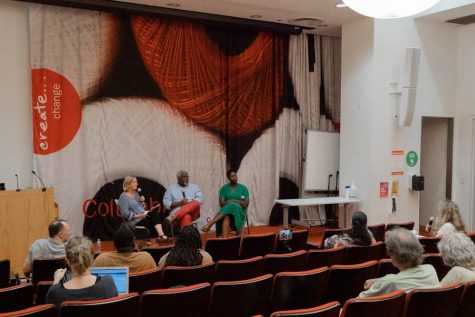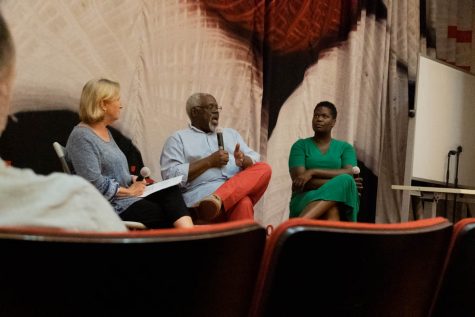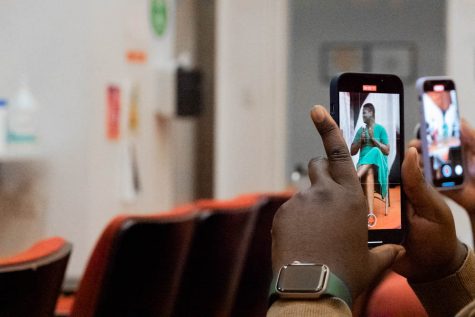Columbia authors talk South Side representation, universal stories at Chicago Writers Association
September 15, 2022

As part of the Chicago Writers Association’s “CWA Presents…” series, Toya Wolfe, author of “Last Summer on State Street” and a 2015 Columbia graduate with a Master of Fine Arts degree in creative writing, took to the stage with her former instructor Eric Charles May, author of “Bedrock Faith” and associate professor in the English and Creative Writing Department.
Wolfe and May’s joint author interview, moderated by CWA board member Sandy Colbert, covered many topics, including the real-life inspiration behind their novels and how Chicago’s South Side communities are represented in the media. The event was held on Sept. 10 at Ferguson Hall, 600 S. Michigan Ave.
As reported by the Chronicle, May’s “Bedrock Faith” was chosen as the One Book, One Chicago 2021 anniversary selection. Wolfe’s debut novel, “Last Summer on State Street,” has been named a Best Book of Summer by Publishers Weekly, Good Housekeeping, Chicago Magazine, the Chicago Tribune and many others, according to the Barnes and Noble website.
While both novels are set in Chicago, “Bedrock Faith” and “Last Summer on State Street” highlight several differences and commonalities about life on the South Side in Black communities through their narratives.
In writing “Bedrock Faith,” May said he wanted to delve into a particular Black middle class that is conspicuously absent in American literature: stories about a neighborhood in which the worst parts of racism are not a defining feature of daily life.
“I wanted to write a story where overt white racism is not driving the drama,” May said at the event, “which is not in any way a denial of that, but simply that African American life is as nuanced as any other culture.”

May said in Morgan Park, where he was raised and was the inspiration for the book’s fictional setting of Parkland, police are not a major presence.
This is in contrast to the former Robert Taylor Homes in Bronzeville, where Wolfe grew up and where “Last Summer on State Street” is set.
“It’s like you breathe, and there are police,” Wolfe said.
At the event, Wolfe talked about how South Side stories should not be homogenized.
“I have a very specific version of the South Side,” Wolfe said. “Eric’s South Side is different from mine. Michelle Obama’s South Side is different. Lena Waithe’s South Side is different.”
Wolfe’s South Side specifically mines the inner lives of four Black girls in 1999.
“When you’re growing up as a little girl, you’re always told what to do, how to be, how to sit, what to wear … I had an opportunity to give these girls some thoughts and feelings and let you actually hear them,” Wolfe said.

May said in mass-marketed literature, news and media, Chicago’s South Side neighborhoods are often pigeonholed into narratives centered on violence. He said diversified stories are written but do not get much attention or disseminated because Hollywood has to appeal to a wider audience that is drawn to a lower common denominator.
May added the lower common denominator is often violence.
Wolfe said TV writers’ rooms are telling Chicago stories from the perspectives of people who do not know what the city is really like.
“A lot of it is written by folks who did not live in Chicago and do not know what it feels like to walk these pavements,” Wolfe said.
May said in the end, writing stories about specific people’s distinct experiences results in emotionally-impactful narratives that appeal to a wider audience.
“When you dive profoundly into the specific, you get to the universal,” May said. “Even though we may never live in the projects … we all know what fear feels like. We all know what being confused feels like.”
Wolfe agreed with May, and said although people today often want to highlight their differences, they have more in common than they think.
“At the end of the day, people want to raise their families,” Wolfe said. “They want to have some fun. Whatever your faith tradition is, you want to try to get close to God. That stuff, it’s universal.”







